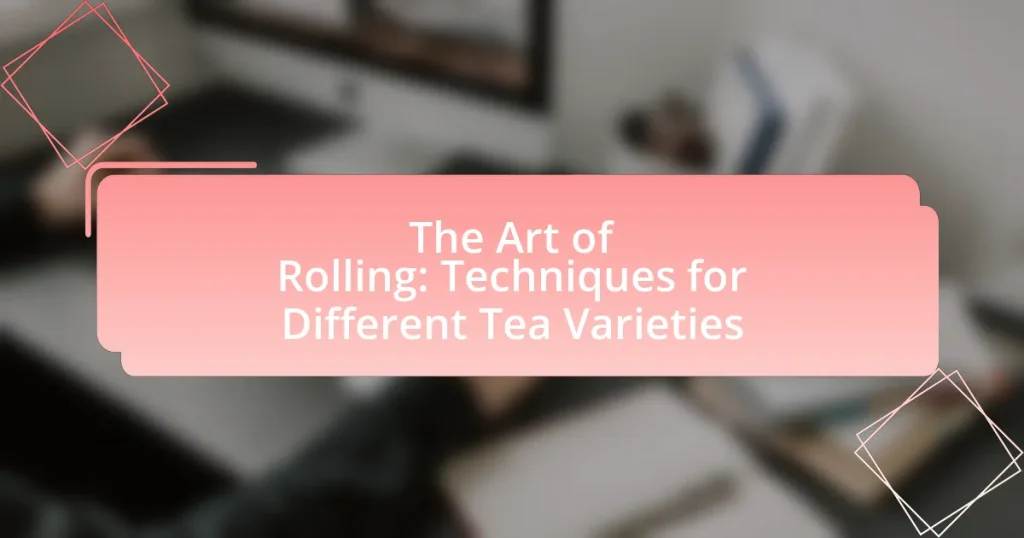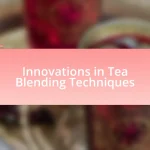The main entity of the article is the various techniques of rolling tea, which play a crucial role in shaping the flavor and aroma of different tea varieties. The article provides an overview of fundamental rolling techniques, including hand rolling, machine rolling, and the use of specialized tools, highlighting their impact on the tea’s chemical composition and sensory attributes. It also explores how rolling affects the flavor profiles of green, black, oolong, and white teas, detailing the historical origins and regional practices that shape these methods. Additionally, the article addresses best practices for rolling tea at home, emphasizing the importance of moisture levels and gentle handling to optimize flavor extraction.

What are the fundamental techniques of rolling tea?
The fundamental techniques of rolling tea include the methods of hand rolling, machine rolling, and the use of specific rolling tools. Hand rolling involves manually shaping the tea leaves to enhance their flavor and aroma, a technique often used in high-quality teas like oolong. Machine rolling automates the process, providing consistency and efficiency, commonly applied in mass production of black and green teas. Additionally, specialized rolling tools, such as bamboo mats or wooden boards, can be utilized to achieve desired leaf shapes and textures. These techniques are essential for developing the unique characteristics of different tea varieties, as evidenced by traditional practices in regions like China and Taiwan, where rolling methods significantly influence the final product’s quality and taste.
How does rolling affect the flavor profile of tea?
Rolling significantly influences the flavor profile of tea by enhancing the release of essential oils and compounds during the oxidation process. This technique allows for a more uniform exposure of the leaves to air, which can intensify the aromatic qualities and overall taste. For example, in oolong teas, rolling can create a complex flavor profile that includes floral, fruity, and creamy notes, as the rolling process facilitates partial oxidation and the development of these characteristics. Studies have shown that the mechanical action of rolling breaks down cell walls, promoting the release of polyphenols and other flavor compounds, which directly impacts the tea’s taste and aroma.
What chemical changes occur during the rolling process?
During the rolling process of tea, significant chemical changes occur, primarily involving the oxidation of polyphenols. This oxidation leads to the development of flavor compounds and the transformation of catechins into theaflavins and thearubigins, which contribute to the color and taste of the tea. Additionally, the mechanical action of rolling breaks down cell walls, facilitating the release of essential oils and enhancing the overall aroma and flavor profile. These changes are crucial for producing the desired characteristics in different tea varieties, as evidenced by studies showing that the degree of oxidation directly influences the sensory attributes of the final product.
How does rolling influence the aroma of different tea varieties?
Rolling significantly influences the aroma of different tea varieties by breaking down cell walls and releasing essential oils and aromatic compounds. This mechanical process enhances the exposure of the tea leaves to oxygen, facilitating oxidation and the development of complex aromas. For instance, in oolong teas, rolling promotes a balance between oxidation and the preservation of floral notes, while in black teas, it intensifies malty and fruity aromas. Studies have shown that the degree of rolling can alter the concentration of volatile compounds, directly impacting the sensory profile of the tea.
What are the traditional rolling methods used in tea production?
The traditional rolling methods used in tea production include hand rolling, machine rolling, and the use of bamboo baskets. Hand rolling involves skilled artisans manually shaping the tea leaves, which allows for greater control over the final product and enhances the flavor profile. Machine rolling, on the other hand, utilizes mechanical devices to process larger quantities of leaves efficiently, though it may result in less nuanced flavors. The use of bamboo baskets, particularly in certain regions, allows for a gentle rolling motion that helps to preserve the integrity of the leaves while promoting oxidation. These methods have been practiced for centuries and are integral to the development of distinct tea characteristics.
How does hand-rolling differ from machine-rolling?
Hand-rolling differs from machine-rolling in that hand-rolling is a manual process that allows for greater control over the shape and texture of the tea leaves, while machine-rolling is an automated process that typically produces uniformity and efficiency. Hand-rolling involves skilled artisans who can adjust the pressure and technique based on the specific variety of tea, resulting in unique flavor profiles and characteristics. In contrast, machine-rolling standardizes the rolling process, which can lead to a more consistent product but may sacrifice some of the nuanced qualities achieved through hand-rolling. This distinction is significant in the production of high-quality teas, where the craftsmanship of hand-rolling can enhance the overall sensory experience.
What are the historical origins of these rolling techniques?
The historical origins of rolling techniques in tea processing can be traced back to ancient China, where the practice began over 2,000 years ago. Initially, rolling was employed to shape and enhance the flavor of tea leaves, particularly during the Tang Dynasty (618-907 AD), when the method became more refined. Evidence from historical texts indicates that the rolling process was essential for producing high-quality green and oolong teas, as it helps to release essential oils and enzymes, contributing to the tea’s aroma and taste. The technique spread to other regions, including Japan and Taiwan, where local adaptations emerged, further enriching the diversity of rolling methods used in tea production today.

What are the specific rolling techniques for different tea varieties?
The specific rolling techniques for different tea varieties include various methods tailored to enhance the unique characteristics of each type. For example, green tea often employs a technique called “pan-firing,” where leaves are rolled and heated in a pan to prevent oxidation, preserving their green color and fresh flavor. In contrast, black tea utilizes a method known as “CTC” (Crush, Tear, Curl), where leaves are mechanically processed to create small, uniform particles that brew quickly and yield a strong flavor. Oolong tea typically involves a “twisting” technique, where leaves are rolled into tight balls or twists, allowing for a complex flavor profile that develops during oxidation. Each of these techniques is designed to optimize the flavor, aroma, and appearance of the tea, reflecting the specific requirements of the tea variety.
How is green tea rolled differently from black tea?
Green tea is rolled differently from black tea primarily due to the oxidation process involved in their production. Green tea leaves are steamed or pan-fired shortly after harvesting to prevent oxidation, and then they are rolled into various shapes, such as twisted or curled, to enhance flavor and appearance. In contrast, black tea leaves undergo full oxidation, which alters their chemical composition and flavor profile; they are typically rolled more loosely to facilitate this oxidation process. This difference in rolling techniques reflects the distinct processing methods that define each tea type.
What unique characteristics define the rolling process for green tea?
The rolling process for green tea is characterized by its gentle manipulation of leaves to preserve their delicate structure and enhance flavor. This process involves lightly rolling the freshly steamed leaves, which helps to break down cell walls and release essential oils, contributing to the tea’s aroma and taste. The unique aspect of green tea rolling is that it is typically done at lower temperatures compared to other tea types, preventing oxidation and maintaining the vibrant green color. Additionally, the rolling shapes can vary, such as twisted or ball-shaped, which influences the brewing characteristics and flavor profile of the final tea product.
How does the rolling of black tea enhance its robustness?
The rolling of black tea enhances its robustness by breaking down the cell walls of the tea leaves, which facilitates the release of essential oils and compounds that contribute to flavor and strength. This mechanical process increases the surface area of the leaves, allowing for better oxidation and a more intense flavor profile. Studies have shown that the rolling technique can significantly impact the chemical composition of the tea, leading to a higher concentration of polyphenols and other beneficial compounds that enhance the overall robustness of the brew.
What rolling techniques are used for oolong and white teas?
Oolong and white teas utilize distinct rolling techniques that enhance their flavor and appearance. Oolong tea is typically subjected to a process called “twisting,” where the leaves are rolled into tight, spiral shapes, allowing for optimal oxidation and flavor development. This technique can vary in intensity, with some oolongs being lightly twisted while others are tightly rolled, impacting the final taste profile. In contrast, white tea employs a gentler method known as “sifting” or “light rolling,” where the leaves are minimally manipulated to preserve their delicate structure and natural sweetness. This technique ensures that the leaves remain intact, which is crucial for maintaining the subtle flavors characteristic of white tea. The differences in these rolling techniques are essential for achieving the desired qualities in each tea type.
How does the semi-oxidation process affect oolong tea rolling?
The semi-oxidation process significantly influences the rolling of oolong tea by altering the leaf’s chemical composition and moisture content. During semi-oxidation, enzymes in the tea leaves react with oxygen, leading to changes in flavor and aroma, which are essential for the rolling technique. This process makes the leaves more pliable, allowing for tighter and more uniform rolling, which enhances the overall quality of the tea. Additionally, the semi-oxidation level determines the final appearance and texture of the rolled leaves, impacting the infusion characteristics during brewing.
What are the delicate considerations in rolling white tea?
The delicate considerations in rolling white tea include maintaining the integrity of the delicate leaves and ensuring minimal bruising during the process. White tea is made from young leaves and buds, which are more fragile than those used in other tea types. Therefore, the rolling technique must be gentle and controlled to preserve the natural shape and flavor profile of the leaves. Additionally, the timing of the rolling is crucial; it should occur after withering but before the leaves become too dry, as this balance affects the final taste and aroma. Proper humidity levels during rolling also play a significant role in achieving the desired quality, as excessive moisture can lead to fermentation, while too little can cause the leaves to break.

How do environmental factors influence tea rolling techniques?
Environmental factors significantly influence tea rolling techniques by affecting the moisture content and temperature of the leaves. High humidity can lead to softer leaves, requiring gentler rolling techniques to prevent damage, while drier conditions may necessitate firmer rolling to achieve the desired shape and texture. Additionally, temperature impacts the enzymatic activity in the leaves, which can alter the rolling process; for instance, warmer temperatures may accelerate oxidation, influencing the timing and method of rolling. These adaptations ensure that the final product maintains optimal flavor and quality, as evidenced by traditional practices in regions like Darjeeling and Assam, where local climate conditions dictate specific rolling methods.
What role does humidity play in the rolling process?
Humidity plays a crucial role in the rolling process of tea leaves by affecting their pliability and moisture content. When humidity levels are optimal, tea leaves become more flexible, allowing for effective rolling without breaking. This flexibility is essential for achieving the desired shape and enhancing the release of essential oils and flavors during the rolling process. Research indicates that a relative humidity of around 60-70% is ideal for rolling, as it prevents the leaves from becoming too dry and brittle, which can lead to poor quality and loss of flavor.
How can temperature variations affect the rolling of tea leaves?
Temperature variations significantly influence the rolling of tea leaves by affecting their moisture content and pliability. When tea leaves are exposed to higher temperatures, they tend to lose moisture more rapidly, making them brittle and less malleable, which can hinder the rolling process. Conversely, lower temperatures can retain moisture, allowing the leaves to remain flexible and easier to roll without breaking. Research indicates that optimal rolling occurs at specific temperature ranges, typically between 20°C to 30°C, where the leaves maintain ideal moisture levels for effective manipulation. This temperature control is crucial for achieving the desired shape and quality in various tea varieties, as improper rolling can lead to suboptimal flavor extraction during brewing.
How do regional practices shape rolling techniques?
Regional practices significantly influence rolling techniques by adapting methods to local tea varieties and cultural preferences. For instance, in China, the rolling technique often emphasizes a gentle, hand-rolling approach to preserve the delicate leaves of green teas, while in India, the rolling process for Assam black tea involves more vigorous mechanical methods to enhance oxidation. These variations are rooted in historical cultivation practices and the specific characteristics of the tea plants grown in each region, such as leaf size and moisture content. The distinct rolling techniques not only affect the flavor profile of the tea but also reflect the cultural significance and traditional practices of tea production in each area.
What are the distinctive rolling methods found in Chinese tea production?
The distinctive rolling methods found in Chinese tea production include the “twisting,” “shaping,” and “rolling” techniques. Twisting involves hand-rolling the leaves to enhance their shape and release essential oils, which is commonly used in oolong tea production. Shaping refers to the process of forming the leaves into specific shapes, such as balls or spirals, often seen in green teas like Longjing. Rolling, a more mechanical method, compresses the leaves to facilitate oxidation and flavor development, particularly in black teas. Each method is tailored to the specific tea variety, impacting the final flavor profile and aroma.
How do Indian tea rolling techniques differ from those in Japan?
Indian tea rolling techniques primarily involve a more mechanical process, utilizing machines to crush and twist the leaves, which enhances oxidation and flavor development. In contrast, Japanese tea rolling techniques emphasize hand-rolling, particularly for varieties like gyokuro and sencha, which preserves the leaf structure and results in a more delicate flavor profile. The mechanical rolling in India often leads to a stronger, bolder taste, while the hand-rolling in Japan maintains the integrity of the leaves, contributing to a lighter, more nuanced flavor. This distinction is rooted in the cultural and historical practices of each country, with India focusing on mass production and Japan prioritizing artisanal craftsmanship.
What are the best practices for rolling tea at home?
The best practices for rolling tea at home include selecting high-quality tea leaves, ensuring proper moisture content, and using gentle pressure during the rolling process. High-quality leaves, such as those from the Camellia sinensis plant, yield better flavor and aroma. Maintaining a moisture content of around 30% helps the leaves become pliable, allowing for effective rolling without breaking. When rolling, applying gentle pressure prevents damage to the leaves while promoting the release of essential oils, which enhances flavor. These practices are supported by traditional methods used in tea production, which emphasize the importance of leaf integrity and moisture management for optimal flavor extraction.
How can beginners effectively roll tea leaves for optimal flavor?
Beginners can effectively roll tea leaves for optimal flavor by gently pressing and twisting the leaves between their fingers to release essential oils and enhance flavor extraction. This technique, known as “rolling,” should be done with care to avoid damaging the leaves, as over-rolling can lead to bitterness. The process allows for better infusion during brewing, as the rolled leaves expand and release their flavors more efficiently. Studies indicate that properly rolled leaves can increase the surface area exposed to water, resulting in a more aromatic and flavorful cup of tea.
What common mistakes should be avoided when rolling tea?
Common mistakes to avoid when rolling tea include excessive pressure, improper moisture levels, and neglecting the specific tea variety’s requirements. Excessive pressure can damage the leaves, leading to loss of essential oils and flavor. Maintaining the right moisture level is crucial; too dry leaves can break easily, while overly moist leaves may not roll properly. Additionally, each tea variety has unique rolling techniques; failing to adapt to these can result in suboptimal flavor and aroma extraction. For instance, rolling green tea requires gentler handling compared to black tea, which can withstand more pressure.


